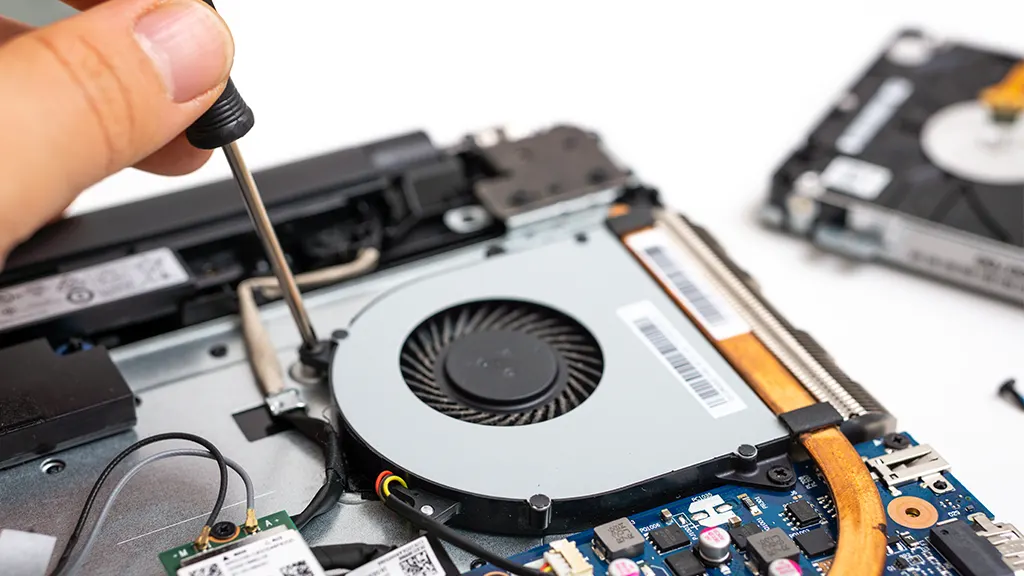How to fix a loud laptop fan

🧰 Difficulty: ★★☆��☆☆ (Looks simple. Isn’t.)
⏱ Time involved: 25+ minutes
⚠️ Risk level: Medium. Clean it wrong, and your laptop could go from noisy to ruined.
💡 Pro insight: We see noisy fans in our stores often—most are just dusty, some are dying. Only opening it tells you which.
⚙️ Skip the guesswork—visit your nearest uBreakiFix® by Asurion store for a free diagnostic.
Whether you're in a meeting or at a quiet coffee shop, a loud laptop fan can be annoying—and embarrassing. But what can you do about it?
At Asurion, we help our millions of customer with all of their tech care needs. From troubleshooting why your laptop won’t connect to Wi‑Fi to figuring out how much memory you need, we keep the devices you rely on most working all day, every day. Here are our tips for fixing a loud laptop fan.
Why is my laptop fan so loud?
If your laptop fan is loud, screeching, or making a grinding noise, it tends to be one of two things: your device is overheating or something inside it—like the fan—is broken. The first issue might even result in the second. A laptop that’s working harder than it should creates excess heat and forces its fan to work overtime to cool it down. Overheating can cause your device to shut down or lead to permanent damage. The good news: a few simple steps often solve it. If overheating’s the culprit, check out our guide to laptop overheating: causes, signs and how to fix them.
How to fix a noisy laptop fan
Before you start, make sure your laptop is on a stable surface and your files are saved. Then work through these quick checks.
1. Put your laptop on a hard, flat surface
Soft surfaces can block vents. Using a desk, table, or a ventilated stand improves airflow and can immediately reduce fan noise.
2. Clean the air vents
Dust can clog vents and force the fan to work harder. Power down and unplug, then use short bursts of compressed air at an angle to clear the vents. Aim for a quick clean every 6 months.
3. Stop programs running in the background
High CPU apps can kick the fan into overdrive.
- Windows®: Press Ctrl + Alt + Delete → Task Manager, sort by CPU, and end unneeded tasks.
- Mac®: Open Activity Monitor via Spotlight, review CPU, and quit what you don’t need. For more ways to reduce background load, see our tips to speed up a slow laptop.
4. Get rid of any viruses
Malware can push your system to run hot. Run a full antivirus scan and remove anything suspicious. If you need help, follow our guide to remove a virus from your Mac or PC.
5. If you use a MacBook, reset PRAM and SMC
These controls on a MacBook® affect power and thermal behavior and can help with fan issues.
- Reset PRAM: Shut down → power on while holding Option + Command + P + R for ~20 seconds.
- Reset SMC: With the laptop off and plugged in, press and hold Shift + Option + Control + Power for 30 seconds, then turn it on.
6. Update your software and drivers
Updates can improve performance and thermal management.
- Mac®: Apple menu > System Settings > General > Software Update.
- Windows®: Start > Settings > Update & Security > Windows Update > Check for updates.
7. Consider a hardware repair
Still loud—especially with grinding or rattling? The fan (or another part) may be failing. Bring your computer to your nearest uBreakiFix® by Asurion store for a free diagnostic and fast, hassle-free repairs.
FAQ
Is it bad if my laptop fan is always loud?
Constant loud fan noise usually means your system is running hot. Occasional bursts are normal, but persistent noise can shorten component lifespan—try the steps above.
How often should I clean the vents?
About every six months, or more often if you’re in a dusty environment or have pets.
Will a cooling pad help?
Yes—elevating the laptop and adding active airflow can lower temps, so the fan doesn’t have to work as hard.
The Asurion® trademarks and logos are the property of Asurion, LLC. All rights reserved. All other trademarks are the property of their respective owners. Asurion is not affiliated with, sponsored by, or endorsed by any of the respective owners of the other trademarks appearing herein.